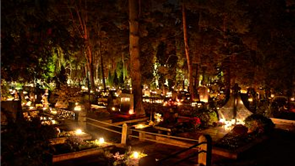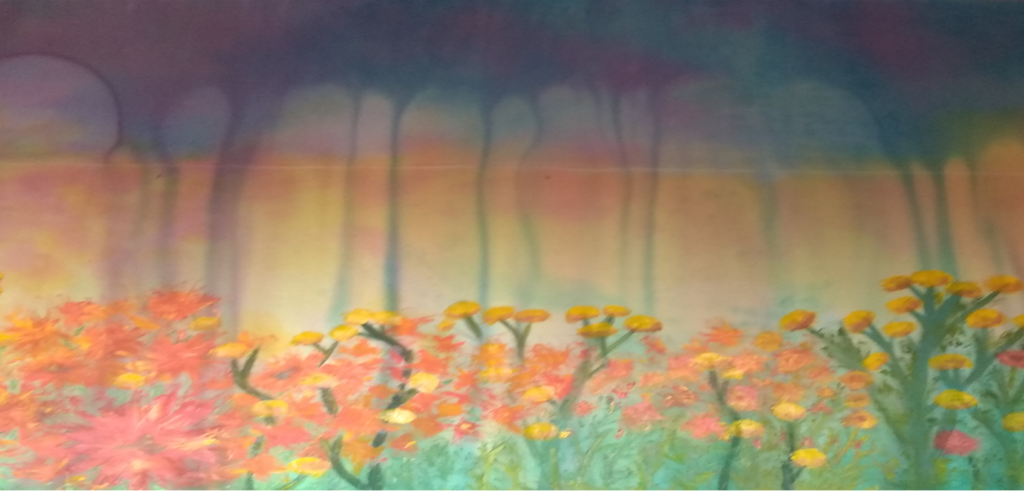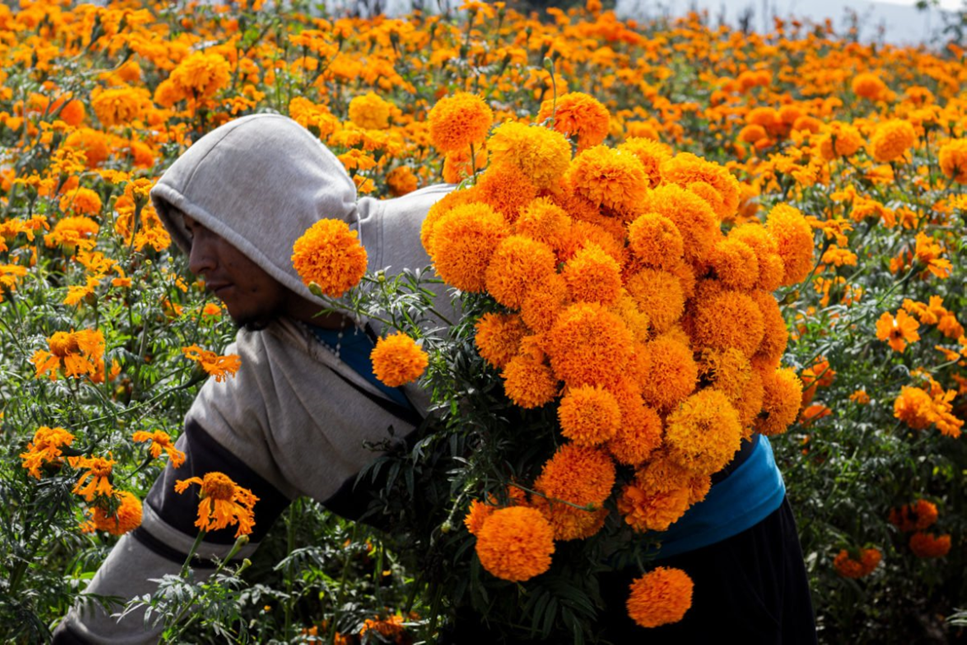Dear BACWTT Students, Alumni, Friends and Colleagues,
Here is the Calendar of the Soul, looking back over the past week.
Calendar of the Soul
Verse 30
English
In sunlight of the soul spring up
The mellow’d fruits of thinking;
To certainty of Self-awareness
All feeling is transformed;
Joyfully I can perceive
The autumn’s spirit wakening.
The winter will arouse in me
The summer of the soul.
Mandarin
思想的果在心灵的光中渐渐成熟,
内观中,感受之流也发生具大的转变,
秋的灵性觉醒带给我喜悦:
冬终将蛰伏与我内在的
夏的灵扬起。
Spanish
Brotan en la luz solar del alma
Los frutos maduros del pensar,
En certidumbre de la consciencia de sí mismo
Se transforma todo el sentir.
Alegre puedo sentir el despertar
Del espíritu de otoño:
El invierno despierta en mi
El alma del verano.
The verse this week follows the gradual process of awakening to the inner world. The dimming of the sunlight and the quietening down of nature corresponds with the growing of an inner light, “the summer of the soul,” which is growing within.
We can hear in the verse the transforming of thinking, feeling and will:
Thinking is becoming mellow/fruitful.
Feeling is leading to self-awareness.
The will is not explicitly addressed, but we can hear something of the will quality in the “wakening” and the rousing to inner activity.
The overall character of the verse conveys a sense of having arrived at a still point, and perhaps this gives rise to the special time in the course of the year that has long been associated with a thinning of the barrier that separates the living from the dead. This is a “liminal time” when it is possible to occupy more than one space or condition simultaneously, when the layers and boundaries do not provide their usual strength of separation between this world and the next.
There are many traditions that recognize this time of the year as one to communicate with those who have crossed the threshold. In the United States, Halloween is a popular festival that has many fun and playful aspects. Like all festivals in our culture, it is subject to commercialization and trivialization, but has its origins in this ancient knowledge.
Halloween originates from All Hallows’ Eve, the evening before All Hallows’ Day on November 1st—the day in the Christian year when holy people are remembered. It is followed on November 2nd with All Souls’ Day, when we remember all who have passed and send positive thoughts and prayers. All Hallows’ Eve, All Hallows’ Day and All Souls’ Day are collectively called Allhallowtide, “hallow” being another word for “holy.”

Here is a brief history of this festival: “On May 13, 609 A.D., Pope Boniface IV dedicated the Pantheon in Rome in honor of all Christian martyrs, and the Catholic feast of All Martyrs’ Day was established in the Western church. Pope Gregory IV through papal decree later expanded the festival to include all saints as well as all martyrs, and moved the observance from May 13th to November 1st in 835 A.D., throughout the Frankish Kingdom. November 1st was already known as an important day in the Celtic calendar – Samhain, placing a Christian feast day on November 1st would have made sense to Northern European Catholic Bishops to subvert pagan ideas and repurpose the pre-Christian pagan celebration.
The Commemoration of the Faithful Departed (All Souls’ Day) was established around 975 A.D. in the Cluniac Catholic Order in Switzerland and then extended to rest of Christendom, set on November 2nd. All Souls’ Day is a time to pray for friends and family who have recently died. The date was placed next to All Saints’ Day to emphasize the idea that Saints could intercede on behalf of the dead. Praying for the dead and remembering the dead with food are precedents for both the eerie and archaic relating to spirits beyond the grave and the ghostliness associated with Halloween. Since the 9th century, Samhain, All Saints Day, and All Souls Day have peaceably coexisted into modern times. This became known as Allhallowtide which is the Triduum, encompassing the Western Christian observances of All Saints’ Eve (Halloween), All Saints’ Day (All Hallows’) and All Souls’ Day, which last from October 31 to November 2 annually. By the end of the 12th century, Allhallowtide had become holy days of obligation in the Catholic Church. In Europe such traditions as ringing church bells for the souls in purgatory and criers dressed in black to parade the streets, ringing a bell of mournful sound and calling on all good Christians to remember the poor souls, became customary. ”
“A number of the Allhallowtide traditions originate from earlier pre Christian times—at this same time the ancient Celtic festival of Samhain was celebrated.
Samhain (pronounced SOW-in) was the first and most important of the four quarter days in the medieval Gaelic calendar and was celebrated October 31st – November 1st, and marked the end of the harvest season and beginning of winter or the ‘darker half’ of the year.
Samhain was also a festival to honor the dead, it was seen as a liminal time, when the boundary between this world and the Otherworld thinned. This meant the ‘spirits’ or ‘fairies’ could more easily come into our world and were particularly active. At Samhain, it was believed that the ‘spirits and fairies’ needed to be propitiated to ensure that the people and their livestock survived the winter. Offerings of food and drink, or portions of the crops, were left out-side for them. Also, the souls of the dead were also said to revisit their homes seeking hospitality. Places were set at the dinner table and by the fire to welcome them. In 19th century Ireland, ‘candles would be lit and prayers formally offered for the souls of the dead. After this, the eating, drinking, and games would begin.’”
Día de los Muertos also happens at precisely this time, and has an ancient heritage reaching back into Aztec and other Meso-American cultures. We have been fortunate in our program to hear the thoughts of Arelly Sanchez-Shackett, a student in the 3rd Year who has been working with others to create a large mural for the festival of Día de los Muertos at Wildcat Canyon Com-munity School.

In creating the painting, Arelly wanted to emphasize the importance of the Mexican marigold in this festival. Its distinctive scent and bright colors encourage and guide the spirits of the deceased to descend and receive the prayers, good wishes and offerings that have been made to them. The painting emphasizes this upward and downward relationship between the flowers and the spirits.
The Mexican marigold is called “cempasúchil” in the Nahuatl (Aztec) language, and has an ancient association with Aztec festivals for the dead.
Arelly also shared her personal memory of the Day of the Dead:
“When I was child, we used to travel 10 to 12 hours from Mexico City to Juchitan, Oaxaca, at the end of October. For on the night of November 1st, our family all went to the cemetery—a place now full of light with candles burning all around. Smoke was coming from all the small anafres where the copal was constantly lit, and it gave the atmosphere a very mysterious character. With the atmosphere so loaded with mystery there was no room for mischief. Children were obedient and cooperative: attending the flowers, helping bring food over from grave to grave, or just sitting and looking.
Since each family had brought special music for their loved ones, and some of the graves were just a foot distant from each other, the cacophony of music was a natural background—that and the murmur of the prayers resonating all around. Often loud crying intermingled with loud laughter—sometimes from the same person! The visiting relatives created the ofrendas just on top of the graves; the graves without relatives visiting also received some attention from an anonymous person. No grave was left unattended. At a certain moment, the music stopped and an el-der in the family spoke loudly, approaching the loved one who had passed away and, expressing feelings of warmth, wishing them the best wherever they are and asking them to come down and receive the offering. Anyone else who wished to speak, young or old, followed. And the rest was simply waiting because once we went home they, the dead, would come (down) and enjoy the offerings. They never came while we were there.
Now, many years have passed, and things have changed. Yet for many, the sacredness of this celebration that has its origins in precolonial times is still recreated year after year, anywhere people are, because it really doesn’t matter how far away we are from the places we come from—we come. It is the gesture that counts, the stories and the attention for details in the offerings placed. Of course, since that famous James Bond movie with its opening set in Mexico City, the whole world got confused about the meaning of this celebration. The Mexican culture has a certain relationship with death, which has many layers of significance. For children who have grown up with this tradition, it is both a moment of joy with all the sweets and colors, and a moment of internalizing without words but just by doing what devotion and sacredness is about. “

As we enter this time of year, I would like to share that underlying Anthroposophy and Waldorf education is the idea that it is possible to continue to be connected to those who have passed away, who are not with us in this physical world. It should be obvious if, on the one hand, we hold the thought that the young child enters the world and life—not from nowhere, but from a non-physical spiritual realm—that on the other hand, when we die we travel through the other gate-way that leads to that spiritual realm again.
For anyone who is interested in exploring this further then you can find much to consider and to work with in the collection of lectures by Rudolf Steiner, Staying Connected: How to Continue Your Relationships with Those Who Have Died:
https://steinerbooks.presswarehouse.com/browse/book/9780880104623/Staying-Connec
Here are some excerpts form the introduction by the editor of this collection, Christopher Bamford:
“Dying touches us all deeply. We all die and so, in our ordinary lives, in the midst of the joys and sorrows we experience, in our work and play, the relations we form, and the children we have, we are continually accompanied—if not consciously then unconsciously—by our own mortality. We are reminded of this daily by loved ones we lose, friends and acquaintances who die, as well as by the myriad anonymous deaths that fill the newspapers, films, and television. Dying is part of living. Yet, during the last few centuries, we have preferred to deny death by making it an end so final that it is unthinkable-a void, absolute negation. We thought we did so because we loved life. In fact, we did so because in our obsession with material things occupying space, we lost the ability to understand that life extends far beyond the limits of our five senses. We lost the sense that the visible world is merely the tip of an unquantifiable, qualitative, invisible reality. That is to say, we ‘lost’ the spiritual world and, having lost it, can no longer imagine that life can take forms other than the purely physical form we have made supreme: the only reality.
Truly, there is a great life. Life is boundless; it is greater than our wildest dreams. And we are part of it-forever. What a puny notion it is to believe that meaning and love in the universe are restricted to what we can achieve with our brain and brawn during the few brief years allotted each lifetime on earth! On the contrary, life goes on, life continues, life is endless. We live it now. We live it every moment. This means that all life is always here, now, and that the dead, as well as the unborn…
In ancient times, when humanity was less physicalized than it is today, everything spoke and every human being was a prophet, able to hear and interpret the words of the gods sounding through all phenomena. Not so much distinction was made as now between interior and exterior, subjective and objective. Heaven and earth were one world and everything was alive with meaning and calling for response. Human beings were still heavenly beings and felt themselves woven into and part of a great symphonic stream…
Gradually, we lost this sense of floating between worlds between heaven and earth in harmonies and rhythms. We came down to earth, to solidity, density-to body consciousness where we could unfold a consciousness of our ‘I’ in action. For a long time we still knew of our heavenly origin. Then we began to forget, and needed to be reminded.
Rudolf Steiner is a twentieth-century representative of a long line of what the Koran calls ‘warners,’ who remind us of our divine destiny in the language and manner appropriate to our time. His message is that we are twofold creatures, children of heaven and earth: visible beings embodied in space and time, and invisible beings of soul and spirit. We live and work and have being in both realms. In both, we are at home. Yet these two, heaven and earth-are in a sense not really two but one: a single reality in two forms. After all, they interpenetrate and reflect each other so perfectly point for point that there is nothing ‘There’ that is not also ‘Here.’ Therefore our lives and our work are continuous, and the relationships and connections we form Here continue There, as does our activity and participation in the divine-spiritual-human cosmic process we call the universe.”
“This is what it comes down to: that we learn to experience that those who have passed through the gate of death have only assumed another form. Having died, they stand before our feelings like those who, through life experiences, have traveled to distant lands, whither we can follow them only later. We have therefore nothing to fear but a time of separation. Spiritual science must help us learn to feel and experience this in the most living way we can.”
Rudolf Steiner, June 17, 1915

Ken
Kenneth Smith
Director, BACWTT








